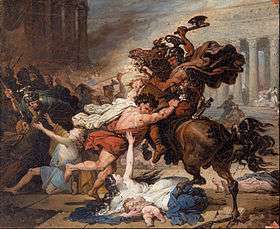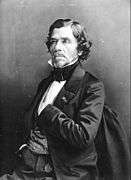Jacob wrestling with the Angel (Delacroix)
Jacob wrestling with the Angel is a mural painted by Eugène Delacroix. Painted toward the end of his life, from 1854–1861, it depicts a puzzling episode from The Bible's Book of Genesis, XXXII, 22-32 - Jacob wrestling with the angel. The painting decorates the wall of the Chapel of the Holy Angels in the Paris church of Saint-Sulpice. Another mural by Delacroix, Heliodorus Driven from the Temple, drawn from the Book of the Maccabees, a scene of someone taking a beating in the Jerusalem Temple, is also there.

.jpg)
In an invitation sent out by Delacroix in July 1861 to inspect the Chapel of the Holy Angels in the church of Saint-Sulpice he wrote : "Jacob is travelling with the flocks and other gifts he is taking to his brother Esau in the hope of appeasing his anger. A stranger appears, blocking his path, and engages him in a fierce struggle - The holy books see this struggle as a symbol of the trials God sometimes sends His chosen ones. " Delacroix does not indicate in what holy books he found such an interpretation.
Maurice Barres wrote that it was 'a final page of autobiography, a summary of the experience of a great life, the last will and testament written by an old artist on the wall of the Angels'. He called it Delacroix's 'spiritual testament ' -- although the French writer Jean-Paul Kauffmann calls Barres' book Mystere en pleine lumiere [ The mystery in Full Daylight] -- 'certainly questionable on the significance of the scene painted by Delacroix'.[1]
In Delacroix's composition, a caravan procession--a convoy of servants, flocks, Jacob's sons and wives--appears then fades, only to reappear briefly at the bend of a ravine. Three huge trees dominate the scene; the gorge with misty contours is the painting's final destination. Thereby, Jacob's life is represented in two parts, as he is not to be the same after the depicted fight. 'He bears the mark for ever in his flesh', victorious but wounded, whereas before the meeting with the angel he is all tricks and cheating. Thus Delacroix depicted a pile of clothes left in the foreground by Jacob, as he has still his bulky animal skin, symbol of animal human nature and the lower instincts, and wears a lion skin across his shoulder: one of whose paws can be seen flying in the air near his right calf. Paul Claudel wrote of the femininity of the angel attacked by a vigorous young man: 'these two bodies becoming aware of each other'
Delacroix's house close to Paris on the edge of the Sénart forest was his retreat during the work and conception of Jacob. He left Champrosay in the morning, took the train to Ris station, and returned in the evening to sleep at the hermitage. "Nature as depicted [here] is not very eastern--the stream, the vegetation, the rise with the three trees definitely belong to the landscape of the Ile de France--Senart forest. Delacroix liked to walk in the woods and be around the decomposing organic matter--had a saprophiliac side to his nature--a fascination with destruction and putrefaction, squelching in mud and breathing in the air of the secluded paths". (Kauffman)
Delacroix wanted to work in the church on Sundays. There were sung masses and the music inspired him. When the Abbé Croquant objected, Delacroix went as far as to request the Emperor and Empress to intervene.
Preparing the wall in Sant-Sulpice--worried by absorption (walls swallow liquid preparations)--"the great enemy is the dampness of the walls:in short the walls are dreadful for any paint. Oil, sinking in to a great depth, can compensate for the drawback." The Chapel faces south, so Delacroix played with the light flowing in directly through the window--a solar architecture - Gnomon of Saint-Sulpice Gnomon astronomicus - the threat of lead poisoning, brought on by breathing the lead n paint - the walls contain white-lead.
'Jacob' is set in an uneven hilly surface. Delacroix, who above all studied Rubens, admired the thickness of Rubens' paint and the way its impasto stands out from surfaces. The Historic Monuments research laboratory has identified an incredible number of layers: indeed, the Angel's robe has up to thirteen.
In 1856 Delacroix was suffering from tubercular laryngitis,the illness that would kill him. A varicocele torments him as its testicular trouble flares up. The nature of his work on the mural 'means that he is always either standing or perched up on a ladder, increasing his discomfort.'


"The names of angels - what is your name?" Jacob asks at the end of the fight.
On 28 December 1857 Delacroix moved his lodgings from rue Notre Dame de Lorette to no6 Rue Furstenberg to be nearer Saint-Sulpice, and by 22 July 1861 he had finished the Chapel of the Holy Angels. He had only two more years to live, time spent most of it in his refuge at Champrosay.
1938 - damaged by sandbags
Deliver me out of the mire, and let me not sink -Psalm 69 verse 14 - this is the inscription over the entrance to the Chapel of the Holy Angels. In October 1858 Delacroix wrote to Berryer, 'I have made a solid effort. I think it will save the work, which was probably bogged down.'
On 28 April 1849, the Ministry of the Interior officially commissions Delacroix to do the mural paintings for the Font Chapel - its name at that time - he had chosen subjects to do with original sin, washed away by baptism - He is 51. He will get 26,826 francs - He learns that the chapel, wrongly called Font Chapel because the baptismal font was temporarily placed there, is dedicated to St Sulpice - On 2 October 1849, it changes name - and this time invokes the Holy Angels. The change obliges Delacroix to look for other themes. He writes in his journal 'The justifiable anger I felt has really knocked me about.' On 5 October 1850 he reveals in a letter to a friend, the painter Constant Dutilleux his subjects, and mentions Jacob wrestling with the angel, Heliodorus, and the ceiling, which will have as its subject the Archangel Michael slaying the Demon. From 1850-54 Delacroix is busy with another commission however, the decoration of the Hall of Peace in the Town Hall and then, on 16 June 1854 writes in his Journal - "Andrieu has begun work at Saint-Sulpice." Pierre Andrieu, was a pupil of Delacroix, before becoming his collaborator from 1850 onwards.
Heim's work in chapel of souls in purgatory on other side of wall to delacroixs mural - 'prayer for the dead' - less looked at- there was a confessional in the chapel of the holy angels - placed beneath wrestling with the angel, enroached on the bottom part of the painting - it was moved - to the heim chapel beneath heims prayer for the dead -
Kauffmann - Titian The Martyrdom of St Peter - inspiration for delacroix?
References
- ↑ Jean-Paul Kauffmann, Wrestling With the Angel: The Mystery of Delacroix's Mural, transl. Patricia Clancy (London: Harvill Press, 2003).
Further reading
- Maurice Sérullaz - Les Peintures murales d'Eugene Delacroix - 1963
- Jack Spector - The Murals of Eugene Delacroix at Saint-Sulpice - The College Art Association of America, 1967
- Rene Huyghe - Delacroix ou le Combat solitaire (Hachette 1964)
- Philippe Vilain?
- Annie Ernaux
- Paul Baudry
- Vision After the Sermon - Gauguin takes up the theme of Jacob wrestling the angel
- Lautréamont - second song of Les Chants de Maldoror and Delacroix' painting?
- Delacroix - "I will die ashamed of having been a man"
External links
- Review by Andrew Motion of a recent book
